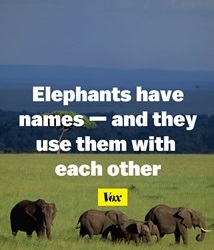Dear Commons Community,
What’s in a name? It’s more than a sound people make to get your attention — it’s a seemingly universal hallmark of human society and language, the specifics of which set us apart from our fellow animals. Now, scientists say they have found evidence with the help of artificial-intelligence-powered tools that elephants call each other by names too.
“They have this ability to individually call specific members of their family with a unique call,” said Mickey Pardo, an acoustic biologist at the Cornell Lab of Ornithology and an author of a study published Monday in the journal Nature Ecology & Evolution.
Elephants’ trumpeting calls might be their most recognizable sounds, but these “are basically an emotional outburst,” Dr. Pardo said. Lower-pitched rumbles, he said, are more meaningful, as they make up a majority of elephant vocalizations and are used in a wide variety of social situations. “A lot of interesting stuff is going on in the rumbles,” he said.
To decode these rumbles, Dr. Pardo and George Wittemyer, a professor of conservation biology at Colorado State University and chairman of the scientific board for the nonprofit Save the Elephants, analyzed 469 vocalizations made by family groups of adult elephant females and their offspring recorded at Amboseli National Park and the Samburu and Buffalo Springs National Reserves in Kenya.
Elephant rumbles can be difficult for the human ear to differentiate, so the researchers used machine learning analysis: Essentially, they relied on A.I. to break down different elephant calls.
Individual elephants seemed to respond to certain rumbles from other elephants, and the researchers fed those sounds into their A.I. tool. “If the calls have something like a name, you should be able to figure out who the call is addressed to just from the acoustic structure of that call alone,” Dr. Pardo said.
So far, the scientists are not sure precisely which part of a vocalization might be the elephant’s “name.” But they found that their A.I. tool’s ability to identify the intended recipient of a rumble far exceeded what random chance would dictate.
They supplemented these analyses with fieldwork conducted by Dr. Pardo and David Lolchuragi, a co-author of the study and a research assistant at Save the Elephants. The researchers played recordings of rumbles to elephants and filmed their responses; they found that the individual elephants reacted more strongly to their “names” than to other calls, perking up their ears and rumbling back.
Another elephant, nicknamed Margaret, calls back quickly when researchers play a recorded sound that may correspond to her name.CreditCredit…Michael Pardo
“I was super excited,” Dr. Pardo said, “especially when we got the playback results, because I think that’s the strongest piece of evidence that the elephants can actually tell, just from hearing the call, if it was intended for them or not, and they respond more strongly to the calls that were originally directed to them.”
Other animals, including dolphins and parrots, have been found to call one another by what scientists have called “names.” But those are imitations of sounds that other individuals frequently make. That’s different from how humans create names — for instance, if your name is John, you probably didn’t get that name because of your tendency to walk around saying “John” repeatedly. But African bush elephants, Dr. Pardo and his colleagues argue, may be the first nonhuman animals shown to call one another by names as humans understand them, based on abstract sounds.
While this finding is preliminary, Dr. Pardo said that elephants calling one another by arbitrary sounds would be significant because humans assign arbitrary sounds to objects in order “to communicate about things that don’t make any imitable sound. It really expands the breadth of things that we can talk about.” It’s too early to say if this means that elephants may have names for other objects, but the way they seem to name one another leaves that open as a possibility.
Caitlin O’Connell-Rodwell, an acoustic biologist at Harvard Medical School who was not involved with the project, described the study as a “game-changer.”
“It’s only been recently, with A.I. and machine-learning tools, that this kind of analysis is now possible,” Dr. O’Connell-Rodwell said. The study’s argument for such sophisticated communication by elephants “makes perfect sense when you’re trying to spread out to forage and need to have specific contact,” she said.
These insights into elephant communication reveal “how important that social fabric is to the very existence of this animal,” Dr. Wittemyer said. “Social bonding is fundamental to everything about elephants,” he said.
This commonality between elephants and humans could even benefit conservation, Dr. Wittemyer said, because it might “help us recognize ourselves in them, which is the only way that we seem to understand anything.”
The text above was taken from an article that appeared in The New York Times.
Tony



